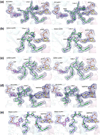Role of arginine 293 and glutamine 288 in communication between catalytic and allosteric sites in yeast ribonucleotide reductase
- PMID: 22465672
- PMCID: PMC3589814
- DOI: 10.1016/j.jmb.2012.03.014
Role of arginine 293 and glutamine 288 in communication between catalytic and allosteric sites in yeast ribonucleotide reductase
Abstract
Ribonucleotide reductases (RRs) catalyze the rate-limiting step of de novo deoxynucleotide (dNTP) synthesis. Eukaryotic RRs consist of two proteins, RR1 (α) that contains the catalytic site and RR2 (β) that houses a diferric-tyrosyl radical essential for ribonucleoside diphosphate reduction. Biochemical analysis has been combined with isothermal titration calorimetry (ITC), X-ray crystallography and yeast genetics to elucidate the roles of two loop 2 mutations R293A and Q288A in Saccharomyces cerevisiae RR1 (ScRR1). These mutations, R293A and Q288A, cause lethality and severe S phase defects, respectively, in cells that use ScRR1 as the sole source of RR1 activity. Compared to the wild-type enzyme activity, R293A and Q288A mutants show 4% and 15%, respectively, for ADP reduction, whereas they are 20% and 23%, respectively, for CDP reduction. ITC data showed that R293A ScRR1 is unable to bind ADP and binds CDP with 2-fold lower affinity compared to wild-type ScRR1. With the Q288A ScRR1 mutant, there is a 6-fold loss of affinity for ADP binding and a 2-fold loss of affinity for CDP compared to the wild type. X-ray structures of R293A ScRR1 complexed with dGTP and AMPPNP-CDP [AMPPNP, adenosine 5-(β,γ-imido)triphosphate tetralithium salt] reveal that ADP is not bound at the catalytic site, and CDP binds farther from the catalytic site compared to wild type. Our in vivo functional analyses demonstrated that R293A cannot support mitotic growth, whereas Q288A can, albeit with a severe S phase defect. Taken together, our structure, activity, ITC and in vivo data reveal that the arginine 293 and glutamine 288 residues of ScRR1 are crucial in facilitating ADP and CDP substrate selection.
Copyright © 2012 Elsevier Ltd. All rights reserved.
Figures








References
-
- Brown NC, Reichard P. Role of effector binding in allosteric control of ribonucleoside diphosphate reductase. J. Mol. Biol. 1969;46:39–55. - PubMed
-
- Thelander L, Reichard P. Reduction of ribonucleotides. Annu. Rev. Biochem. 1979;48:133–158. - PubMed
-
- Stubbe J. Ribonucleotide reductases: the link between an RNA and a DNA world? Curr. Opin. Struct. Biol. 2000;10:731–736. - PubMed
-
- Nordlund P, Reichard P. Ribonucleotide reductases. Annu. Rev. Biochem. 2006;75:681–706. - PubMed
-
- Chabes A, Thelander L. DNA building blocks at the foundation of better survival. Cell Cycle. 2003;2:171–173. - PubMed
Publication types
MeSH terms
Substances
Associated data
- Actions
- Actions
- Actions
- Actions
- Actions
- Actions
Grants and funding
LinkOut - more resources
Full Text Sources
Molecular Biology Databases
Miscellaneous

